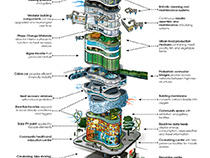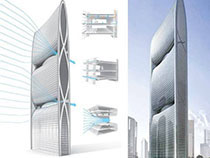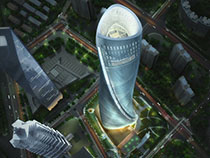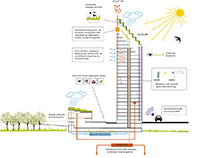CONTROVERSY OVER SUSTAINABILITY. Alberto Clementi 
The experience of Toronto contained in this issue of EWT causes us to reflect on some aporias of the concept of sustainability, not always included in academic, cultural and institutional debates. For years Canada has been known for its marked sensitivity to environmental questions and it has often taken on an avant-garde role regarding sustainability strategies. In particular one must remember the teachings of Michael Hough, who is perhaps not as well-known internationally as he should be, but he was certainly very influential in Canada’s urban and environmental planning. Already in the 1960s Hough was asking many of the questions that exploded on the scene in the following decades, preparing the architects and urban planners of Canada so that they were ready to experiment with a more integrated relationship between the natural and built-up environment, in its cities and territory. As Angrilli reminds us in this issue, Hough was a forerunner in preaching the mutual dependence between city and nature, inspiring the successive movements of Landscape Urbanism and Ecological Urbanism and pioneering the studying of landscape architecture oriented toward the sustainable development of an urban ecosystem.
So the most culturally advanced positions in the area of sustainability found fertile ground to test ideas, in a country with a solid international reputation for its respect of nature and attentive to the environmental equilibria found within its metropolises. However with a marked maturity in its concept of sustainability, including the making of cities with the least possible impact on the environment, but at the same time including in the mix – as Sliwka notes in his essay also found in this issue of EWT – crucial aspects such as economic vitality, a balanced distribution of incomes, low crime risk, an appropriate supply of social and cultural infrastructure, together with other aspects connected to social unease, such as levels of poverty among the young or access to subsidised housing by the least well off part of the population.
One cannot deny that the “impressive blooming” of skyscrapers, which is making Toronto the metropolitan area with the world’s largest concentration of ongoing construction projects, raises many perplexities and leads one to question the environmental virtues of the Canadian model, at least as regards what can be elicited from the experience of its most populous city. The ambitious programme which during the same period has aimed at the environmental regeneration of the waterfront by promoting processes to re-naturalise of extensive degraded areas rescuing them from their former polluting uses is only slightly offsetting. Nor does it count for much that the largest greenbelt in North American has been planned to contain the sprawl effects of its urban expansion, leaving however sacks of concentrated development with their high density of buildings. The overall sensation is that currently Toronto, differently from, for example Vancouver, is in no way behaving itself as a model of sustainable development whose example is to be followed, this notwithstanding there have been episodic interventions of qualifying environmental recovery.
In reality the issue is more controversial than it appears, because it brings into question a typology of building which is often shrouded in the mantle of sustainability when presented by its proponents, architects or real estate promoters, justifying this by showing that it furnishes the latest and most advanced environmental performances effectively reducing its ecological footprint.
There can be no doubt that contemporary skyscrapers, as pointed out in particular by Arup, tend more and more to become sophisticated urban machines, able increasingly to use a variety of systems of self-supply for the resources it needs to maintain itself, together with smart control which aims at optimizing its multiple functions. The facilities they can have today are really remarkable: an internal device to collect and recycle waste; aero generators to produce wind energy; solar panels on the façades which are able also to interact with changes in external climatic conditions; integrated systems to recover heat; materials in the layer covering their façades that convert CO₂ to oxygen; integrated systems for the production of renewable energy and for the recovery and reuse of rain water; vegetation within the structure and even advanced systems, usually hydroponic, to produce food to be locally consumed. By definition skyscrapers consume a minimal quantity of urban soil, satisfying one of the most important conditions toward the goal of sustainable urban development.
The favour that green skyscrapers are meeting in these last years, shows that these buildings are not only motivated by a search for visibility and image by promoters, or by market logic to best exploit building areas, above all where land values are particularly high or where land scarcity forces vertical development, as in Singapore. In fact there are even some appreciable further advantages, in particular from the point of view of the concentration of activities and services, of the reduction of the need for vehicular mobility, of proximity between residential and work spaces and of a better exploitation of environmental resources like wind and insolation. A tangible demonstration of this is the Pearl River Tower in Guangzhou, which was designed by SOM so as to use its powerful turbines to best exploit the wind and free it from the need of external energy, or the 632 metres tall, nearly finished Shanghai Tower by Gensler, in the Pudong area of Shanghai. One third of the site is given over to vegetation, and its wind generators, lighting systems and systems to protect it from external thermic variations are particularly sophisticated bringing about a significant reduction of the overall “carbon footprint”.
Though appreciating these important eco-efficiency performances, considering skyscrapers as green buildings, or at any rate highly sustainable ones, continues to appear a substantial aporia. Not only because this type of building requires particularly high construction and maintenance costs, or needs a very large amount of material for its construction, or even because it includes serious risks, not only from possible dysfunctions of its complex vital devices, but also because it is often considered as a high profile target for terrorist attacks. In more detail, not only because it requires a higher consumption of energy as compared to traditional buildings for multiple reasons, such as the necessary special construction technologies for the great heights, the resistance to the stronger winds found at higher altitudes, and above all to the exorbitant operating costs, for the continual functioning of the lifts and other systems, and of the difficultly of the periodic maintenance of the façades.
The fact is that sustainability, by its very nature, requires a moderate approach in its consumption of non-renewable resources, and is at the same time capable of offering identity living environments with high quality use, flexible and adaptable to evolving needs, and at any rate coherent with the expectations and imaginary of the population. So, it is not only solving the problems of adapting to the context, which in some cases appear particularly worrying, as for example in contemporary London, where valuable historical settlement patterns are being shredded by the reckless introduction of tall buildings, often extemporaneous expressions directed by the randomness of market processes. One must also take into consideration the effects due to an overload of activities and users in areas that often have fragile equilibria, and that risk collapsing under the excessive pressure caused by new skyscrapers (this problem is however treated effectively in Canada, by imposing integrative measures on developers).
We know that sustainability will be played out in the overall functionality of urban ecosystems, and from this point of view an intelligent and hyper-technological machine like a green skyscraper may turn out to be incompatible even when it manages to reduce the size of its “carbon footprint”, only because at the same time it produces negative externalities that reflect on the overall urban metabolism. At any rate the life styles and the expectations of the population are decisive. Too often the inhabitants are forced to accept residential models foreign to their experiences, different from the model of city and landscape that they inherited from the past.
If then – as in the case of Toronto – the skyscrapers that are being built as a crown around the downtown, in the Hyburbia referred to by Hardwicke & Hertel in this issue, are forced to reduce significantly their green appeal because of their excessive costs, then things become further complicated and urban sustainability becomes more elusive than ever.
However, the heated confrontation between those who, like David Owen, appreciate the virtues of high density metropolises and those instead who favour more balanced solutions, based on European models, remains open. It is probable that much reflection is still needed to objectively evaluate sustainability questions and the contribution they can bring to the construction of contemporary metropolises each in its different historical and geographic context. This research must include considerations that have not yet been studied in sufficient depth and that will probably increasingly entwine the outlines of sustainability with the more complex ones of the quality of the settled environment and the ways its inhabitants desire to live it.





